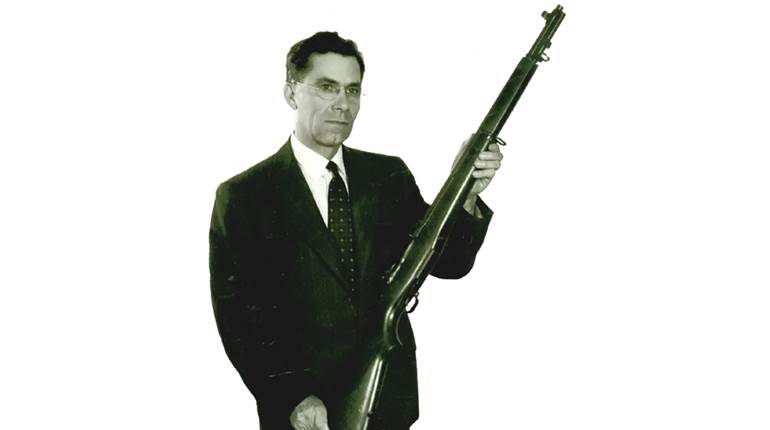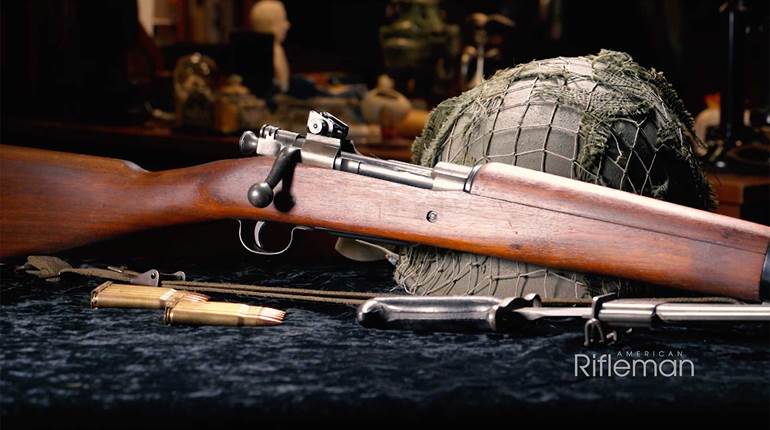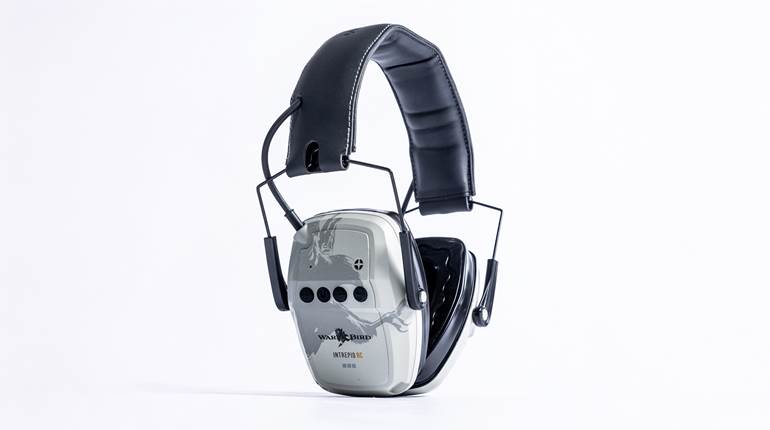
This article originally appeared in the June 1984 issue of American Rifleman. To subscribe to the monthly magazine, visit the NRA membership page and select American Rifleman as your magazine of choice.
When the head of one of America's famous arms companies is curious about a "new and radically different" repeating gun, it is worth exploring the principle a little more. I was meeting Colt's chairman of the board, Maj. Gen. Charles T. "Buck" Lanham, at the Army & Navy Club in Washington in May of 1957. The item for discussion was something called "the open-chamber principle," which Buck Lanham said was being used with triangular rounds by a man named Dardick.
Because of the obvious difficulties in practice, Gen. Lanham asked me to find out how Dardick applied this to his gun. I still have the pocket memo page from which he carefully tore the "Colt" trademark, but Gen. Lanham is gone and secrecy itself is foolish, for the open-chamber principle in its practical form was used a century before by a versatile yet unknown inventor of Staunton, Va., one Lorenzo Sibert, a Confederate States citizen.
 Sibert's "Virginia Pacificator" was a working model; eight magazine tubes surround the barrel.
Sibert's "Virginia Pacificator" was a working model; eight magazine tubes surround the barrel.
Enshrined in a display case at the Virginia Historical Society in Richmond is the only known gun of Lorenzo Sibert, dramatically engraved "The Virginia Pacificator." This, the original patent model, was saved at the dispersal of Patent Office relics by D.J. Harrill of Falls Church, Va. Through the courtesy of Rebecca Perrine, Curator of Special Collections at the historical society, I recently was permitted to examine the enigmatic but not automatic gun model. And "there lies the rub," for if Sibert, whose gun had the enormous capacity of 48 shots without reloading, had gotten into production, those gallant Southrons who claimed they could "whup th' Yankees with cawnstalks" might have done just that in the first year of the war with the "Pacificator."
A very serious group of Virginia Good Old Boys had formed the Staunton Arms & Ordnance Company to manufacture the Sibert on March 1, 1861. Associated with the inventor were John Marshall McCue, John D. Imboden, M.G. Harman, a man named Richardson, and E.M. Taylor, and their declared intent was to manufacture in Augusta County "firearms and ordnance of every description." Capital was not less than $50,000 nor more than $300,000, and the company could use land up to 500 acres as necessary.
 Patent Fig. 13 shows the secret of Sibert's gun. Two fluted rollers carry the cartridge into line for firing, and then down and out.
Patent Fig. 13 shows the secret of Sibert's gun. Two fluted rollers carry the cartridge into line for firing, and then down and out.
Imboden, later famous as a battle-worthy Confederate general, was a colorful promoter of Shenandoah Valley industry.
The association of Imboden and McCue with the Sibert rifle confirms that the design, while remarkable to the point of being astonishing, was considered as a soberly practical device, and one urgently needed after Sumter was fired on April 14, 1861.
Gunsmith William Shaffer of North River Gap west of Staunton built the patent model in "Kentucky" style. His signature and "1860" appear inside the shell gate in the right stock plate. The main frame is brass, and a crack where the barrel screws in has weakened the model but need not be a weak point in design. None of the steel cartridge shells remain with the model.
The promoters acquired the Virginia Central Railroad freight depot in Staunton for $3,500 and hoped to have 20 or 30 hands at work—local pride expected Staunton soon to rival Chicopee Falls or Springfield in production. Called "the greatest gun of the age" by the boosting Staunton Spectator newspaper, it was said to shoot 600 times a minute "consecutively for 12 hours" or 100 times a minute in an ounceball caliber, e.t. .44 to .52 bore.
Gov. Letcher and Richmond Mayor Mayo and sundry Virginians were enthusiastic about the design, and so Col. McCue and Lorenzo Sibert went off to Washington in July to see about a patent and visit their fellow Virginian, Secretary of War John B. Floyd. His letter of July 10, 1860, they preserved and published. Written "for the record," he said, "Whenever such specimen of this arm is presented as you desire, it will afford me pleasure to have it tested by a Board of Ordnance Officers."
 The eight magazine tubes are not connected with the barrel but are retained in place by a cap plate screwed onto the muzzle. A hinged sliding plate swings out for loading the magazine tubes.
The eight magazine tubes are not connected with the barrel but are retained in place by a cap plate screwed onto the muzzle. A hinged sliding plate swings out for loading the magazine tubes.
Floyd expressed the belief that Sibert's rifle would "prove an extremely valuable addition to breech-loading and repeating arms," but a move by Congress forestalled his ordering a hundred or more for field trials, as had been done only a few years before with Colt's revolving rifles.
Apparently, a larger caliber arm of 40-shot capacity was made for them at Harpers Ferry. This weapon was examined by the Spectator on Jan. 22, 1861. Sibert claimed it would shoot a mile with force and accuracy.
Cartridge breechloaders were being invented currently with the Sibert. Powder and bullet were in a single container, usually metal, sometimes with priming attached, a "cartridge" or "fixed round." Some cartridges were steel mini-chambers into which the bullet fitted, with a percussion cap placed over a nipple on the back. The Gatling of 1862 and the Ager Battery Gun were of such design. It was this style which Sibert used in his open-chamber gun.
 When charged magazine tube is brought into line with the J-shape recess on left, it is held in position by spring detent (missing, center, top) engaging notches in bottom of magazine.
When charged magazine tube is brought into line with the J-shape recess on left, it is held in position by spring detent (missing, center, top) engaging notches in bottom of magazine.
Some of the first cartridge guns had a reciprocating breech bolt to close the back end of the barrel. The cartridge went into a special section of barrel; the "chamber" was then fired, and the bolt or plug pulled back to remove the empty case and then insert a fresh round, as in the Henry or Spencer repeaters. Sibert did away with this reciprocating motion, inventing the open chamber described in his patent specification, U.S. Patent No. 32,316 issued May 14, 1861:
"... in the combination of two fluted rollers arranged to constitute an open receiving chamber for the loaded cartridge, and in which it is securely held until expelled therefrom by the succeeding cartridge..."
He conceived of:
"... dividing the breech by a vertical slot passing entirely through it, to permit the passage of the cartridge through the same with only the detention necessary for its explosion..."
This concept was a step further than the Gatling or "Coffee Mill" guns. In those the steel chamber-cartridge was held in line with the back of the barrel by a groover rotor, fired and then rotated out, and a fresh round put into place. Sibert added another rotor or roller. Each was on line with the bore, parallel to the barrel but at the breech, and the cartridge was supported momentarily on its entire circumference and length by the fluted channel in each roller.
 The barrel and magazine group unscrew from the standing breech, and the ends of eight magazine tubes are seen. Each tube could hold six rounds.
The barrel and magazine group unscrew from the standing breech, and the ends of eight magazine tubes are seen. Each tube could hold six rounds.
Gravity fed the shells from a top-positioned tube magazine, and as the external right side cocking lever was thumbed back, an internal "conveyor" pressed the fresh shell into the fluted roller. The fired case dropped below and slid back into the buttstock cavity. Later, the fired shells taken from the butt cavity could be reloaded using a lever and shell holder conveniently fitted to the underside of the stock. Eight magazine tubes surround the barrel, and may be rotated into loading position. The model arm is about a yard long, with a stubby 14" barrel of .24 cal.
Sibert appreciated the value of removing heat from the gun by rapid discharge of the hot cartridge case. The gun model has been fired, but the rifling is sharp, with six narrow grooves. Sibert's cleaning system was novel.
As the Spectator said:
"There is no ramrod, nor is one needed as the gun is cleansed by a new process exceedingly simple and which can be applied to any gun— viz. to discharge a piece of guttapercha in the shape of a ball, which carries all the dirt with it."
The butt side-plate resembles a patch box and was engraved by Canfield & Bro. of Baltimore. "THE VIRGINIA/PACIFICATOR" surrounds the coat of arms of Virginia, with the motto Sic semper tyrannis. Two five-point and two six-point stars complete the right design. The left sideplate repeats the six-point stars, but surrounding the engraving of hands clasped in friendship is the poem:
"A union of guns and a union of land, A union no power shall sever. A union of hearts & a union of hands, And the American union forever."
The poem is circled by 34 stars symbolizing the states of the Union in 1861. Evidently Sibert still hoped for Federal adoption, or perhaps the sentiment was only to convince the patent examiner. Issued in May after Lincoln's call for volunteers, it is believed to be the only U.S. patent on firearms issued to a Confederate citizen.
Gen. Imboden and Col. McCue were already in the arms business before setting up the Staunton company. On Jan. 23, 1861, with Joseph R. Anderson of the Tredegar Iron Works and the Tredegar's chief engineer, Col. James Henry Burton, and others, they had formed the Virginia Arms Manufacturing Co. The Sibert group now turned to them for tooling, perhaps using the military-style Harpers Ferry-built model.
 Positioned beneath the Virginia coat of arms and resembling a patch box is the oval trap which allows the removal of spent cartridges.
Positioned beneath the Virginia coat of arms and resembling a patch box is the oval trap which allows the removal of spent cartridges.
On March 11, 1861, Burton sent an estimate of machinery suitable to make 3,000 Sibert rifles yearly. Including $15,000 in fixtures, the basic plant came to $41,405. They expected to use bored but not finished barrels from another source; possibly Virginia Arms would sub-contract? Although the model does not show how it could be affixed, Burton figured into the deal several machines for boring and turning bayonet sockets, and two machines for buffing bayonets, and a double-frame tilt hammer for forging bayonet blades. "The cost of motive power, shafting, pulleys, gearing, forges, furnaces, etc. and cost of transportation of machinery and erecting, as also the adaptation and alteration of buildings, is not estimated for, in the absence of special information on these points," the Confederacy's master armorer concluded.
A 48-shot repeater in a close-in cavalry war might have been a deciding tactical weapon. But in a war of musket tactics and line-abreast foot soldiers, the fighting was to be with single-shot smoothbores, and then more accurate, shattering Minie rifles. Sibert and his rifle and his Union-forever sentiments faded from history.
Descendants of Sibert, including great-great-grandson William F. Sibert of Staunton, know nothing about his parents nor where he came from, or died. He married Rebecca Georgiana Thresher of an old family in the mountains: Thresher Creek is an important headwater of the Piney River east of the Blue Ridge in Amherst. Their son, Hamilton Francis Sibert, was born about 1853 near Van Buren Furnace in Shenandoah County. He married Eveline Hanger Eidson, again of an old family: Eidson's Creek is crossed by Route 254 south west of Staunton. On early Augusta County maps of about 1850, a place near Buffalo Gap is marked "Siberton."
The Sibert open-chamber principle was to be picked up again about 1900 by an unknown inventor, possibly an American. At an Illinois gun collectors show in the 1950s an oval-shaped, hand-crank pocket machine gun attracted much notice. The device had two feed openings on top and fluted rollers forming two open chambers for .30-30 cartridges as parallel extensions of the two Winchester 94 carbine barrels sticking out of the front. The chamber flutes supported the brass cartridge cases at the moment of explosion, then rotated them out the bottom of the gun. The casing was painted olive drab; the barrels were the usual Winchester blue. Very professionally made, it was unmarked. Possibly the concept of Sibert, studied by James H. Burton, the Confederate ordnance man, was passed on to his son, Frank, who was an engineer at Winchester about World War I. It is a thread to trace.
 Strong "Union" sentiments during a time of disunion embellish the silver plate on stock's left side.
Strong "Union" sentiments during a time of disunion embellish the silver plate on stock's left side.
By the 1950s, David Dardick and his mentor A.J. Miranda, formerly of the American Automatic Gun Co., had returned to weapons design with their openchamber handgun shooting triangular cartridges called "trounds." This created a flurry in the industry, and Colt Firearms wanted to know more, discreetly. I visited David Dardick at the company's New York office suite overlooking Central Park and there also met Miranda.
The operational Dardick guns I saw and have owned did not use the concept of the triangular cartridge expanding into another form before rupture, as Gen. Landham supposed they would. The triangle was only a package-handling idea, the fluted chamber forming two sides of the triangle. The gun frame top strap closed the top of the chamber over the tround.
Earliest trounds were machined of aluminum, with moveable front pieces to gas seal. Some simply supported conventional cartridges, such as .38 Spl. cases. Others, moulded of Cycolac plastic, could be reloaded. Loads equaling the .220 Swift were tried. The trounds rose from inside the handgrip magazine, fitted into the flutes of the rotor, were carried opposite the barrel, fired, and ejected with each pull of the trigger. The pistol was bulky but essentially, except for the odd cartridge, a conventional handgun. With a quick-change barrel and shoulder stock, a pistol carbine for hunting was also offered. But David Dardick's real purpose was to develop a military aircraft cannon using the trounds. He gave credit for the cannon to his associate, Col. Melvin Maynard Johnson, Jr., USMC, who was the innovator of what became the Vulcan aircraft machine cannon.

Mel Johnson, while visiting Cleves Howell at the China Lake Naval Testing Station in California, had resurrected the idea of the electric Gatling from the inventor's patent of the 1890s. Back east, Johnson borrowed an 1886 Gatling from Winchester, hooked up an electric motor, and proved the design was practical. But Dardick moved a step ahead. The Gatling/ Vulcan had chambers, one for each of its six barrels. Removing and ejecting the cartridges and feeding fresh rounds consumed much of the time of operation. Dardick, by simply shifting trounds past firing points, intended to speed that up immensely. He showed me a wooden mock-up of a 10-barrel gun, the barrel group nicely balanced on bearings spun briskly when struck with the palm of the hand. The Vulcan fired 6000 shots a minute. Dardick wanted to build a 20 mm cannon on his "open chamber" principle, feeding from four different stations, achieving a rate of 20,000 shots a minute. He proposed to put a cluster of these guns in the nose cone of a missile.
When fired into space, the open chamber guns' bursts would spread a cloud of metal fragments five miles square, through which in theory no enemy atomic missile could penetrate without destruction. As a "clean" anti-ballistic missile, the open chamber principle, with its mechanically possible extremely high rate of fire for machine guns, is worthy of development. It might yet do what Lorenzo Sibert quixotically hoped to do: preserve "the American union forever."
About The Author
Formerly assistant editor of Gun Digest and founder-editor of Guns Magazine, William B. Edwards is also author of Civil War Guns and other books and articles on weapons. He wishes to express his deep appreciation to William F. Sibert for his kind assistance in the preparation of this article.




































